4.05.2018
First Block 5 Falcon 9 readying for static fire ahead of Bangabandhu-1 launch
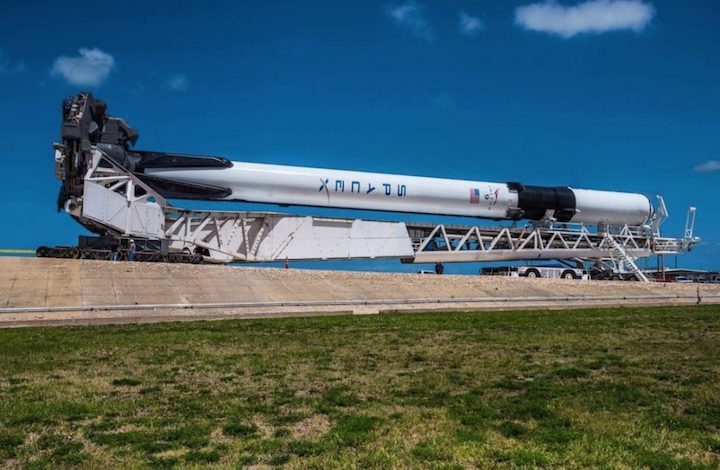
Preparations are underway for the on-pad static fire of the first Block 5 Falcon 9 at Launch Complex 39A. The vehicle – notably including core 1046, the first Block 5 first stage – will launch the Bangabandhu-1 satellite into a geostationary transfer orbit (GTO). This mission – currently scheduled to launch at 4:08 PM EST on May 7, but could be delayed – will be the first for 39A since the Falcon Heavy demo flight on February 6, 2018. The static fire test has a window from 12 PM-8 PM EST on May 4.
The star of the show is the new, unflown first stage core 1046, which is the first “Block 5” Falcon 9 first stage.
Block 5 is the final major upgrade to the Falcon 9, the culmination of over 10 years of development and evolution of SpaceX’s workhorse rocket.
Block 5 has numerous advantages over past versions of the Falcon 9, notably including higher thrust engines, improved and more resilient recovery hardware, and the ability to be reflown within 48 hours of landing after a previous mission. Block 5 was also designed to meet – and in some cases exceed – NASA’s strict Commercial Crew Program requirements, which SpaceX must follow in order to be able to fly NASA astronauts, expected to begin in early 2019.
Block 5 cores are also expected to be reused 10 times before undergoing any major refurbishment, and SpaceX hopes to fly each booster up to 100 times before it is retired.
Core 1046 was first seen traveling from SpaceX’s HQ in Hawthorne, California to their test site in McGregor, Texas. The core was later seen on the first stage test stand at McGregor on February 26, 2018, undergoing preparations for its future static fire tests.
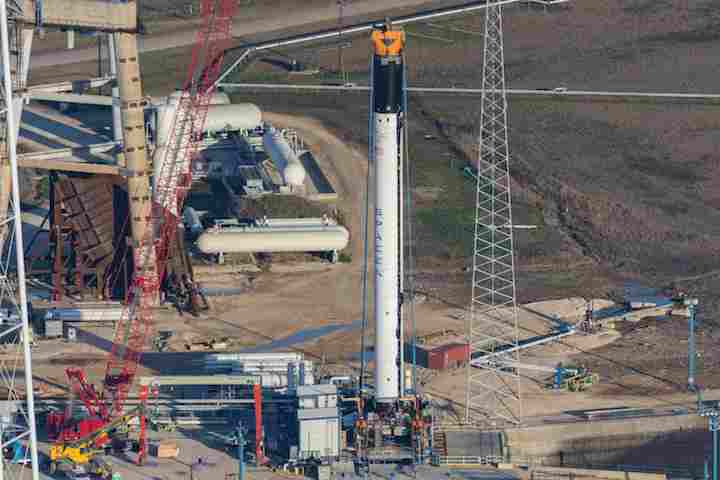
Core 1046 performed three very short “burst” static fires on the test stand from March 11-13 – one each day – before performing a full duration static fire on the night of March 15. After the static fire tests, the booster was then transported from SpaceX’s McGregor test facility to the Horizontal Integration Facility (HIF) at the base of Launch Complex 39A (LC-39A) at Kennedy Space Center in Florida.
Core 1046 and its second stage are currently undergoing preparations on LC-39A for the on-pad static fire test – one of the last major hurdles before launch.
All static fire tests since the Amos-6 on-pad anomaly in 2016 have been without the rocket’s payload and the fairing, to ensure minimal risk for the customer’s payload should something go wrong during the test.
The static fire test consists of a simulation of the entire launch countdown, including rolling the vehicle – minus its payload – out of the HIF and raising it vertical on the launch pad. The rocket is powered up, and the tanks on both stages are filled with propellant. The test ends with a 3.5 or 7 second firing of the 9 Merlin 1D engines on the first stage, depending on whether or not the vehicle contains a flight-proven – or already flown – first stage.
After the firing is complete, the fuel tanks on both stages are drained and the vehicle is transported back into the HIF for integration of the payload.
Meanwhile, engineers and flight controllers at SpaceX HQ in Hawthorne, CA and SpaceX Launch & Landing Control just outside of Cape Canaveral Air Force Station perform a quick analysis – appropriately referred to as a “quick look” – of the test data and soon after announce whether or not the test was a success on Twitter.
The static fire test also ensures the rocket, pad and range systems are functioning properly, along with the new automated flight termination system – a unique feature of the Falcon family.
The payload on this flight is Bangabandhu-1, the first geostationary satellite from Bangladesh. The satellite was designed and built by Thales Alenia Space in France, based on their Spacebus-4000B2 platform.
Once in orbit, it will be operated by Bangladesh Communication Satellite Company Limited. It weighs 3500kg – which is on the lighter end of the geostationary payloads launched by the Falcon 9.

Rendering of Bangabandhu-1 in orbit. Credit: Thales Alenia Space
Its primary purpose is to relay communications, providing service to mainly Bangladesh and surrounding countries. It is expected to be in operation for 15 years. The satellite has 14 C-band and 26 Ku-band transponders onboard.
Since Bangabandhu-1 is a relatively light GTO satellite, the Falcon 9 first stage will have enough propellant leftover to perform a landing on SpaceX’s East coast Autonomous Spaceport Drone Ship – or ASDS – Of Course I Still Love You.
After Bangabandhu-1, the next launch on SpaceX’s radar is the joint Iridium NEXT 6/GRACE-FO mission, launching from Vandenberg Air Force Base in California, currently scheduled for May 19. SES-12 will be next, launching from SLC-40 at Cape Canaveral Air Force Station on May 24. Both missions will use flight-proven first stages and will be closing off SpaceX’s launches for May.
Quelle: NS
---
Update: 8.05.2018
.
SpaceX Set to Debut Newest Falcon 9 Rocket: 'Block 5'
SpaceX is set to debut the latest, most advanced version of its workhorse Falcon 9 rocket this Thursday (May 10).
The company determined that its first Falcon 9 "Block 5" booster is ready to go, after analyzing data from a routine prelaunch static-fire test that occurred Friday (May 4) at historic Launch Pad 39A at NASA's Kennedy Space Center in Florida.
"Targeting Falcon 9 Block 5 launch of Bangabandhu Satellite-1 on May 10 from Pad 39A in Florida," SpaceX representatives wrote on Twitter today (May 7).
Bangabandhu 1 is a communications satellite that SpaceX is launching for the government of Bangladesh.
The two-stage Block 5 Falcon 9 is designed to take reusability to new heights. SpaceX has landed and re-flown numerous Falcon 9 first stages over the past few years, but none of these individual boosters has launched more than twice. Block 5 first stages, however, are designed to fly 10 times with just inspections between landing and liftoff, and 100 times with some refurbishment involved, SpaceX representatives have said.
"Block 5 basically summarizes all that we learned on reusability," Hans Koenigsmann, SpaceX vice president of build and flight reliability, said last month during a news conference before the launch of NASA's Transiting Exoplanet Survey Satellite, which lifted off atop a Falcon 9 Block 4. "It's a reliability upgrade that combines reliability and reusability."
When asked to provide an example of one of the Block 5's improvements, Koenigsmann cited materials in the first stage's heat shield, near the engine base. "But there's a lot of details here that are very technical," he added.
The Block 5 has also been designed to meet NASA's crew-carrying requirements. Like Boeing, SpaceX holds a contract to ferry agency astronauts to and from the International Space Station; such flights could begin in the next year or so.
Reusability is key to SpaceX's long-term vision, which involves helping humanity become a multiplanet species. Full and rapid reuse of rockets and spacecraft could eventually slash the cost of spaceflight enough to make such ambitious goals economically feasible, company founder and CEO Elon Musk has said.
SpaceX has Mars in its sights. The company is developing a huge, reusable rocket-spaceship combo called the BFR, which Musk envisions helping set up a million-person city on the Red Planet in the next 50 years or so. If everything goes well, the first BFR flights to Mars could lift off in the mid-2020s, SpaceX representatives have said.
The BFR will also be capable of launching satellites to Earth orbit, taking people on superfast "point-to-point" trips around the planet and doing pretty much everything else that SpaceX needs to do. Indeed, SpaceX plans to phase out all of its spaceflight systems except the BFR over time, Musk has said.
Quelle: SC
---
Update: 10.05.2018
.
SpaceX's next-gen 'Block 5' Falcon 9 ready to pave the way for company's future
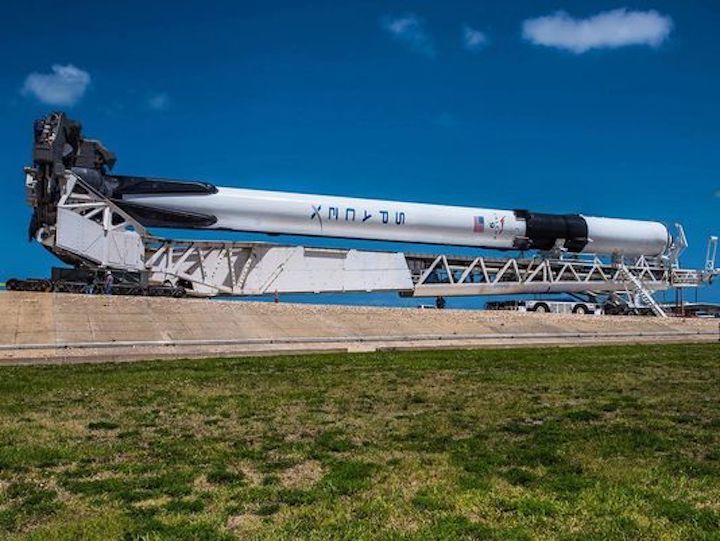
Air Force weather forecasters expect 80 percent "go" conditions for the launch of Bangladesh's Bangabandhu-1 communications satellite, citing the presence of thick clouds as the only concern. A delay to Friday would see a drop to 60 percent favorable for the same reason.
Stationed a couple hundred miles off Florida's east coast in the Atlantic Ocean, the Of Course I Still Love You drone ship will play host to the booster's landing attempt shortly after liftoff, bringing back the hardware that could fly more 10 times or more with light refurbishment. For comparison, older Block 4 versions flew a maximum of two missions before retirement.
Some notable upgrades for Block 5 include:
- An enhanced heat shield at the base to better survive re-entry, which gives the rocket more reusability capabilities.
- A different interstage, or segment that sits between the first and second stages, that now sports an unpainted, black look.
- Retractable black landing legs, compared to the Block 4's white ones.
- More thrust produced by the rocket's nine Merlin main engines.
If all goes according to plan for Block 5, SpaceX could launch more missions with fewer rockets, all while having to oversee less work in between. Company CEO Elon Musk has in the past likened the efforts to that of aircraft, noting that Boeing does not build a brand new 747 for every flight but instead relies on checkups and routine maintenance over decades of service.
Those improvements, SpaceX believes, will lead to more robust profit margins and help the already-prominent rocket gain an even deeper foothold in the launch services industry.
Block 5, however, will be the final version of the workhorse Falcon 9 family, now the most popular rocket in the world and priced at about $60 million per launch. SpaceX has its eye on bigger ambitions: The 350-foot-tall Big Falcon Rocket, or BFR, which will help the company reach the red planet and was recently approved for production at the Port of Los Angeles.
Falcon 9 and its three-core sibling, Falcon Heavy, will fill the gap and help fund research and development until BFR's debut.
On board for Thursday's mission: Bangabandhu-1, Bangladesh's first-ever geostationary communications satellite. The 8,000-pound spacecraft is expected to spend up to 15 years in orbit serving countries ranging from Turkmenistan to the west and the Philippines to the east, giving the Bangladesh Communications Satellite Company a digital foothold in the region.
"Departing for Florida to witness historic Bangabandhu Satellite-1 launching," Zunaid Ahmed Palak, state minister for the country's Information and Communication Technology Division, said via Twitter on Monday. "Please keep us in your prayers so that we can safely launch our first satellite of Bangladesh."
Quelle: Florida Today
+++
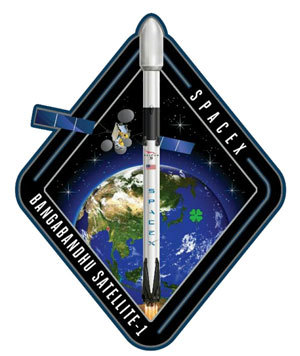
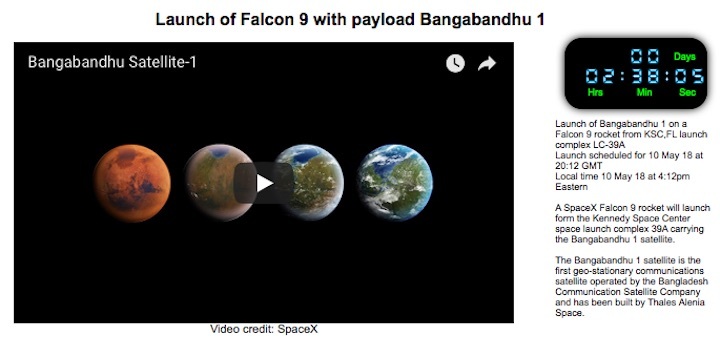
Quelle: AS
---
Update: 11.05.2018
.
BANGABANDHU SATELLITE-1 MISSION
SpaceX is targeting launch of Bangabandhu Satellite-1 on Friday, May 11 from Launch Complex 39A (LC-39A) at NASA’s Kennedy Space Center, Florida. The launch window opens at 4:14 p.m. EDT, or 20:14 UTC, and closes at 8:14 p.m. EDT, or 00:14 UTC. A backup launch opportunity is available on Saturday, May 12 from 2:21 p.m. EDT, or 18:21 UTC, to 6:21 p.m. EDT, or 22:21 UTC. Bangabandhu Satellite-1 will be deployed into a geostationary transfer orbit (GTO) approximately 33 minutes after launch.
The Bangabandhu Satellite-1 mission will be the first to utilize Falcon 9 Block 5, the final substantial upgrade to SpaceX’s Falcon 9 launch vehicle. Falcon 9 Block 5 is designed to be capable of 10 or more flights with very limited refurbishment as SpaceX continues to strive for rapid reusability and extremely high reliability. Following stage separation, SpaceX will attempt to land Falcon 9’s first stage on the “Of Course I Still Love You” droneship, which will be stationed in the Atlantic Ocean.
Quelle: SpaceX
---
Update: 12.05.2018
.
Launch-Frams:
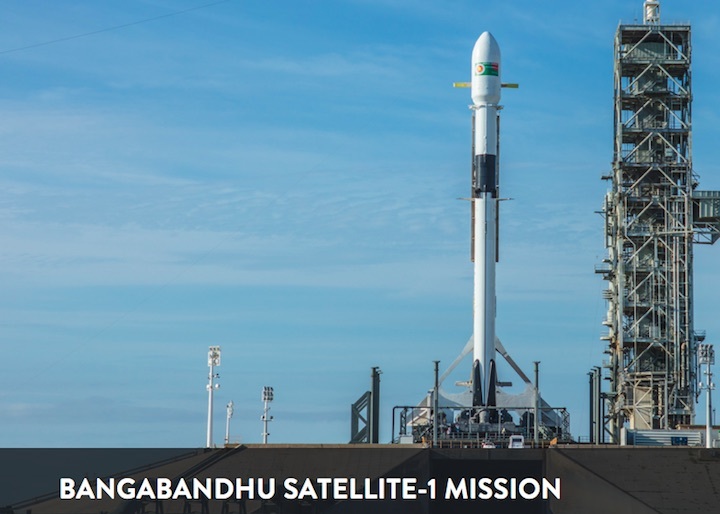
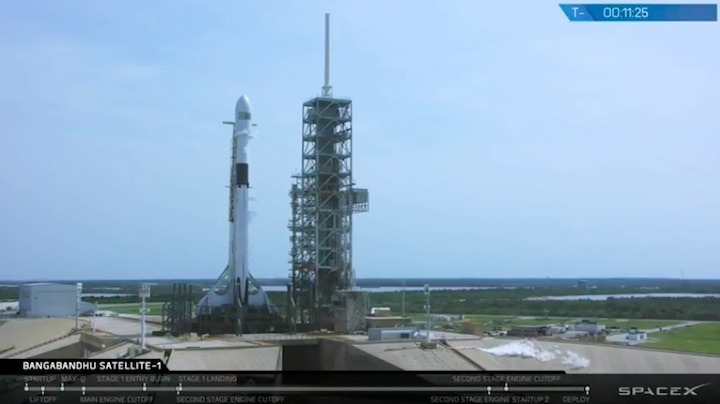
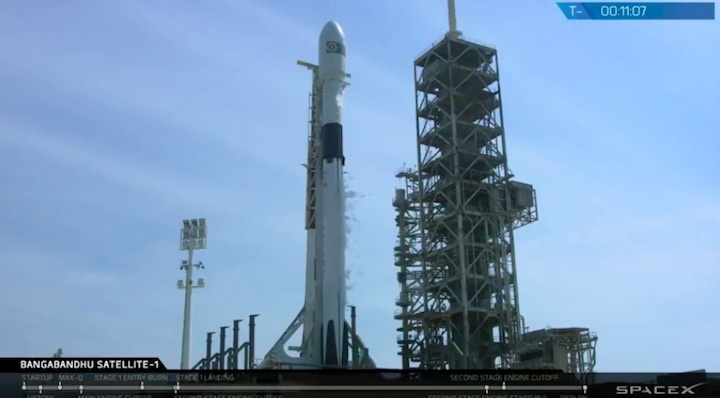
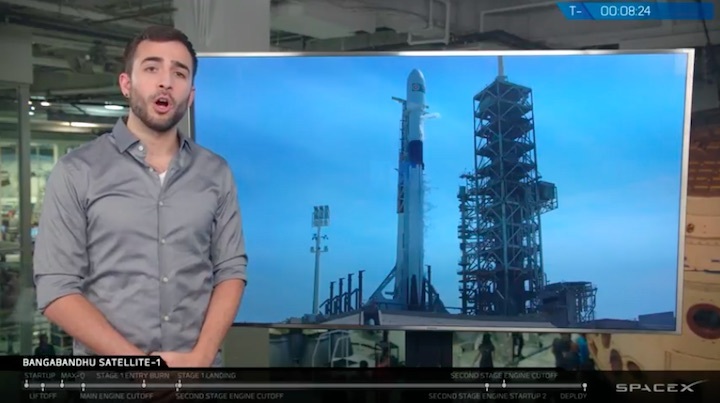
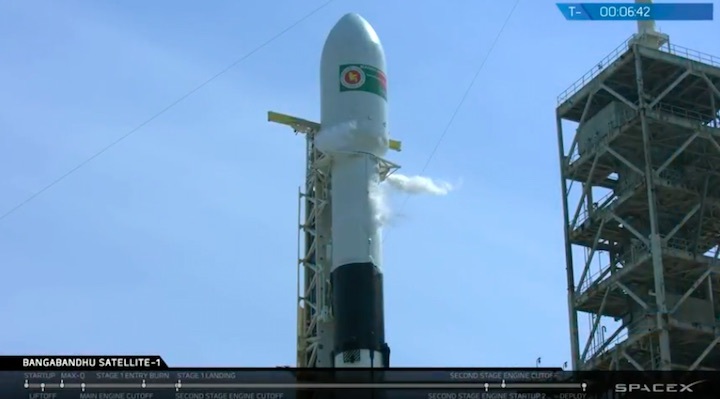
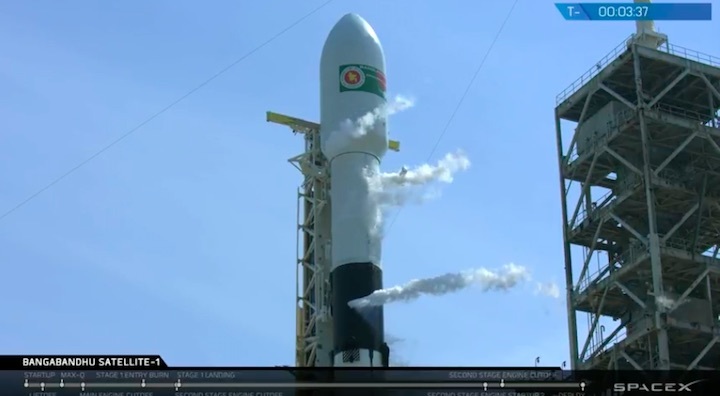
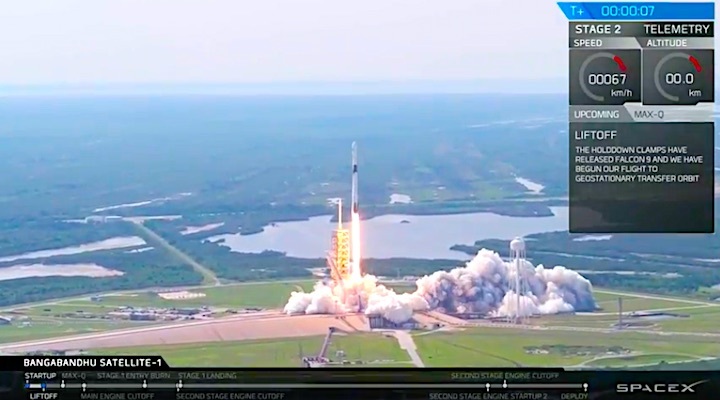
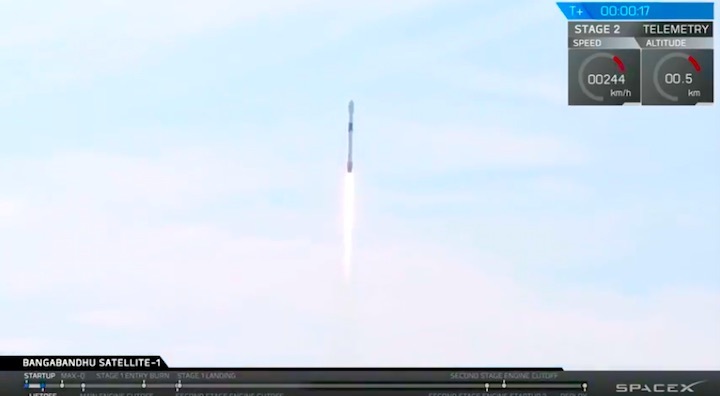
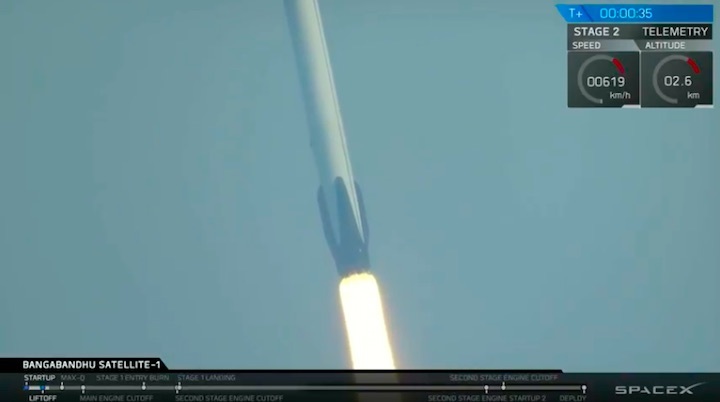
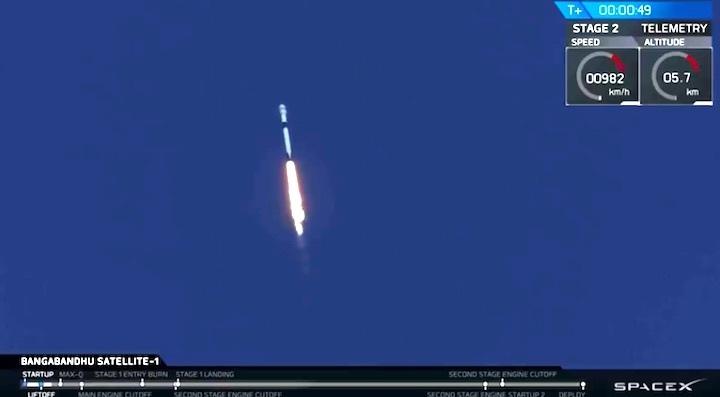
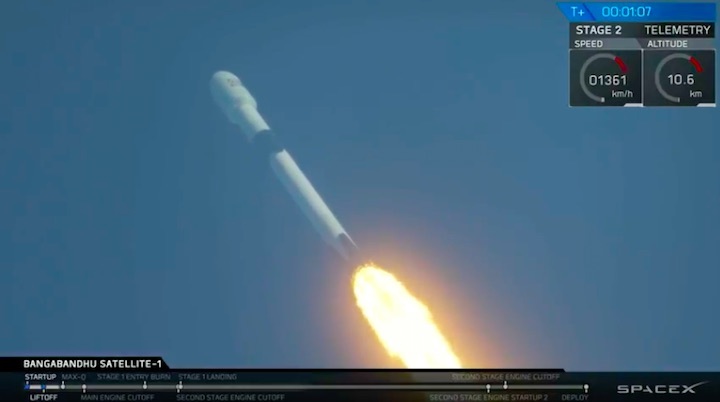
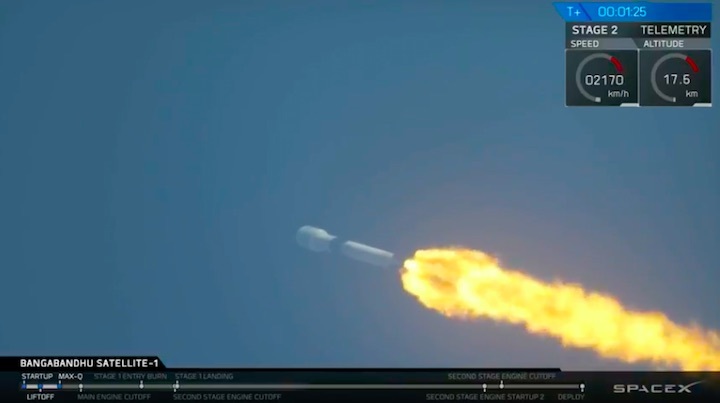
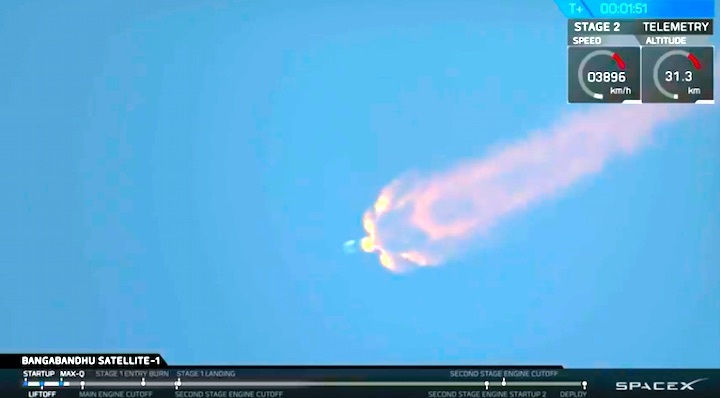
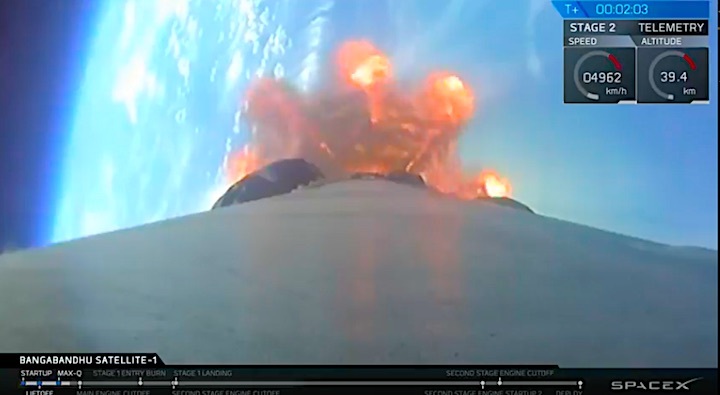
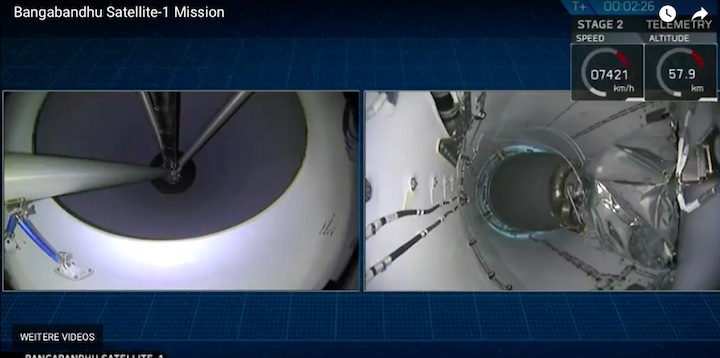









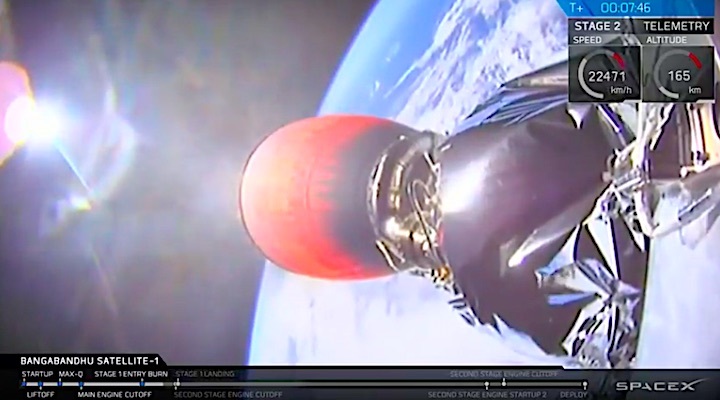

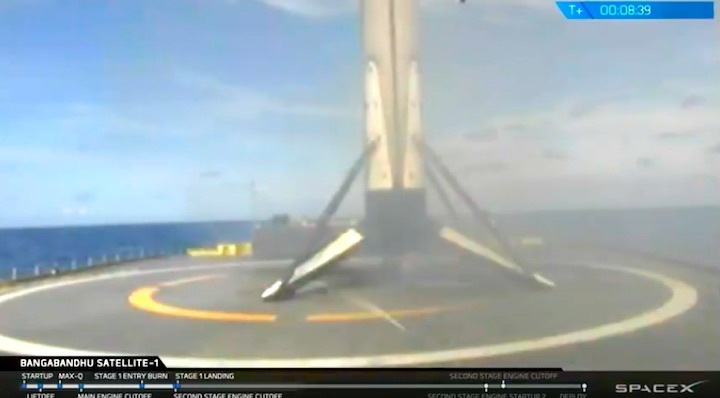
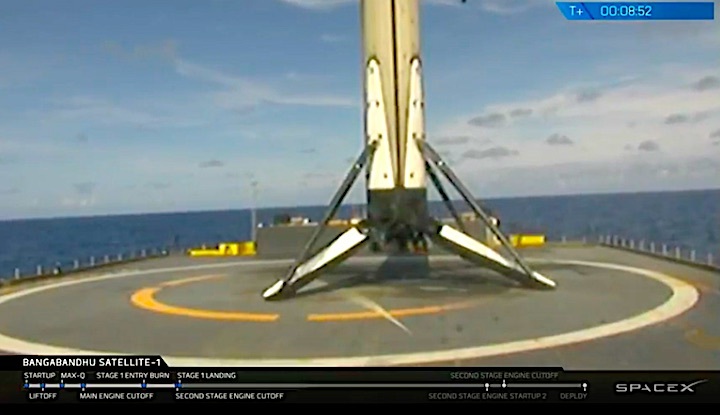

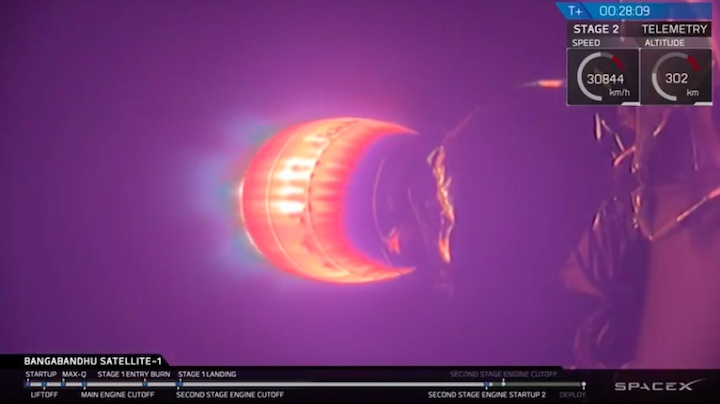
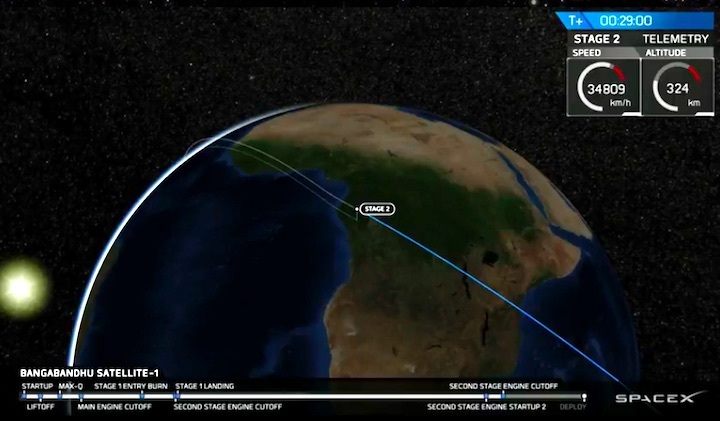
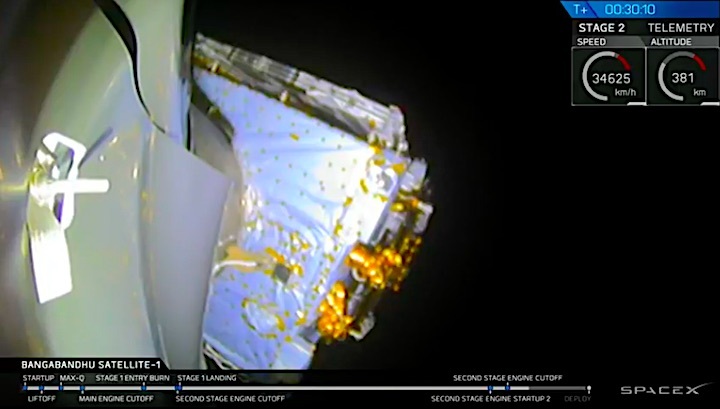
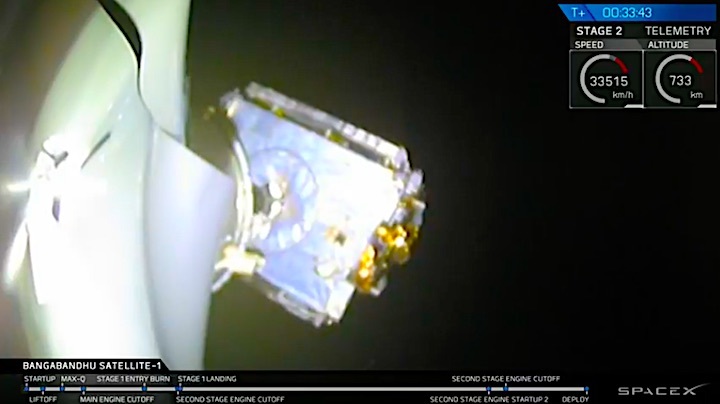
Quelle: SpaceX
